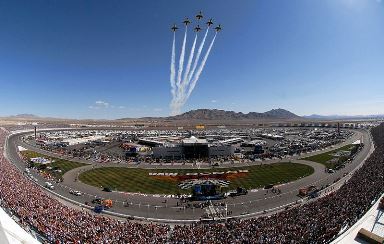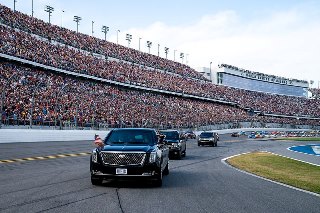Sports
NASCAR: Race Tracks
NASCAR Races
and Racetracks NASCAR Cars NASCAR
Glossary
Back to the main NASCAR
page
NASCAR has races on about 26 racetracks throughout the United states. Most of the tracks hold races for all the NASCAR series of races, however, some are unique to a particular series. Many of the more popular tracks like Daytona Speedway are also raced twice a year.
 Source: US Air Force
Source: US Air Force
The shape and length of each NASCAR track varies. The most standard shape is the oval track. These racetracks vary in length from the shortest track, which is Martinsville Speedway, at 0.53 miles to the longest track, which is the Talladega Superspeedway at 2.66 miles. Another popular type of track is the tri-oval like the Michigan International Speedway. Lowe's Motor Speedway in North Carolina is a quad-oval and Darlington Raceway is an oval with different length ends. One of the most uniquely shaped tracks is Pocono Raceway which is a triangular oval shape. To really change things up, NASCAR has two road races that are a complex shape with all sorts of turns.
There are three general terms used for the length of racetracks. If a racetrack is less than 1 mile, the track is called a short track. If it's greater than 2 miles long, the racetrack is called a Superspeedway. NASCAR racetracks that fit in between these two lengths are usually call intermediate tracks.
Another item that makes each racetrack unique is the banking on the turns. Each track has it's own degree of banking. This makes for different top speeds and different handling on each coarse again making the drivers and race cars adjust from week to week on how they prepare and race.

The President at the Daytona 500
Source: White House
All in all, it's the uniqueness of each racetrack that makes NASCAR interesting to watch from week to week. Different race teams and driver excel on different types of tracks, but the champion must excel on all of them.
Back to Sports
More NASCAR:
NASCAR Races and Racetracks
NASCAR Cars
NASCAR Glossary
NASCAR Drivers
List of NASCAR Race Tracks
Auto Racing Biographies:
Jimmie Johnson
Dale Earnhardt Jr.
Danica Patrick

